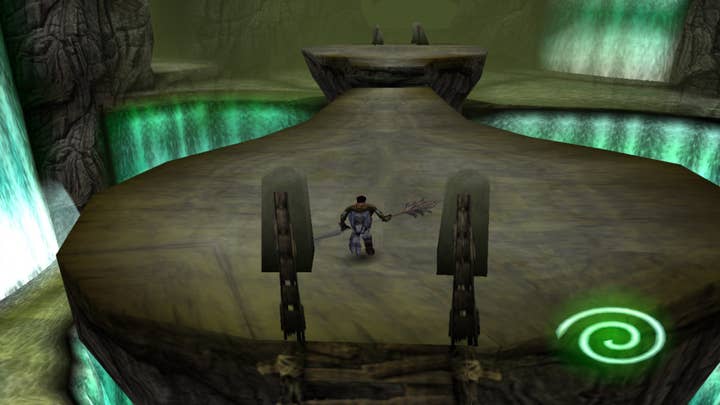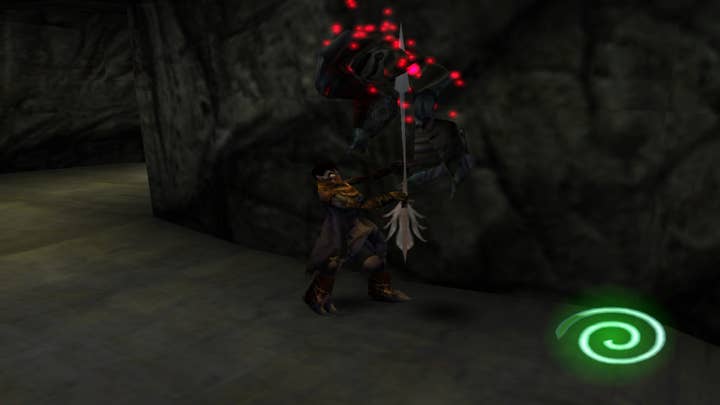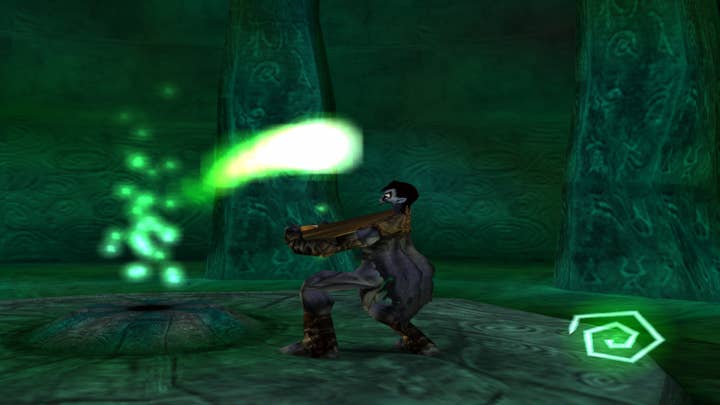Soul Reaver: Audacious, pulpy, intelligent, trashy, uncompromising
Why I Love: TheChineseRoom's Dan Pinchbeck pays tribute to Crystal Dynamics' PSOne vampiric action-adventure
Why I Love is a series of guest editorials on GamesIndustry.biz intended to showcase the ways in which game developers appreciate each other's work. This edition was contributed by Dan Pinchbeck, creative director of The Chinese Room, the studio behind Dear Esther and Everybody's Gone to the Rapture.
I first discovered Soul Reaver by accident. I was just getting back into video games after I borrowed a PSOne and fell completely in love with Tomb Raider II. I was looking for games with a similar sense of scale and adventure.
Puttering around the shop, there was something about Soul Reaver's gothic aesthetic that drew me in. I'm not normally a big fantasy fan, but it had something, and the moment I popped the disc in, and the voiceover goes "Kain is deified! The clans tell tales of him," it just felt like something different. Before the game has even started, the main character has his wings shredded, is thrown into an ancient lake to dissolve over millennia, and then we flash forward hundreds of years where he's been reanimated as a sort of half-vampire / half-walking corpse. Throw in a Cthulhu-esque entity telling him about something called the "wheel of fate" and I was hooked!
The team at Crystal Dynamics did not disappoint - I absolutely loved every minute of it. I don't think there was a slack second in Soul Reaver, which isn't bad going given how much open, empty world it contains. It was just so unashamedly epic and audacious!
On one level, it was a simple revenge story about vampires, but on another, it was this operatic parable about fate and free will, with a cast of characters that was utterly fascinating (more on that later). Plus, it looked absolutely gorgeous for its day and played like a dream. Well, maybe not quite a dream, but it was the PSOne era, and we were happy with tank controls and cameras working off bumper buttons, so the bar wasn't admittedly that high by modern standards - but it felt good. The Spirit Realm mechanic - in which you could travel to an alternate plane and watch the world warp and shift in real-time - was utterly phenomenal. I still feel like it's a really, really incredible mechanic in terms of how it affects environmental traversal, puzzles, and combat situations.

Soul Reaver is so overflowing with ideas and imagination, it could contain these absolutely extraordinary locations without feeling the need to offer some gameplay-altering prize at the end. It had the courage of its convictions to say, "It's completely okay to just leave the player exploring a space with no reward other than the mythos and the world. That's its own reward!"
I remember swimming to a seemingly secret space called the Human Citadel, where scrappy survivors had set up a colony to hide from the vampires. It didn't matter that there's little to do there; there may have been a glyph at the end, but that wasn't the point. The point was you wanted to be there, because the world was so cool and so engaging. Little touches like the fact that the knights who initially attacked you just lost heart and started falling to their knees and worshipping you when you went near... it's those things that elevate the player experience and they aren't even true game mechanics. That was a definite early inspiration for me.
If you can inspire the player to situate themselves in a world, that gives you more to draw on than any kind of gameplay mechanic you can throw at it
It's not a secret that aspects of Soul Reaver were excised from development due to a rushed release schedule, but this seemingly unfinished aspect was a happy accident because it gave the world a feeling of expansiveness. After all, it was supposed to be a desolate failing world, and it feels like it. It's unpopulated. Where is everyone? What's going on? That feeling of emptiness just came together perfectly with the narrative of the game. This was something we saw in future games like S.T.A.L.K.E.R. (another one of my favourites I can blather on about for ages) or Team Ico's titles, where the emptiness is the point. Nosgoth is lonely. It's savage. The old gods are all dead, it would seem. I may not know exactly what was cut, but it's a world in ruin, so whether it was on purpose or not, the world we got felt fully formed.
That's something I've always admired about [Soul Reaver director] Amy Hennig's work. She never underestimates the power of the player's imagination. If you can inspire the player to situate themselves in a world, that gives you more to draw on than any kind of gameplay mechanic you can throw at it. She fundamentally understands that this is a story being told in collaboration with the player; that you have to meet each other in the middle of this space and spin this story together. As a world builder, your job is to supply the player with the architecture and tools to be able to bring this story to life. I think she grasps that on such an incredible level. It's why she's one of the best creative directors in our industry. I think statues of her should be put up outside every game development studio.
[Soul Reaver lead designer] Richard Lemarchand is a phenomenal designer as well. His innate understanding of the relationship between mechanics and narrative is something that's now much more expected, but at the time few games were combining storytelling with more mechanical elements in a way this nuanced. Take the combat system, for example. Since you're fighting vampires, you can't simply punch or claw them to death. You need to scavenge for a makeshift weapon to impale them through the heart. Or a torch to set them ablaze. Or a ray of sunlight to fry them to a crisp. There was a sense of improvisation that fits the narrative dressing so well, that every action you take feels meaningful within the world. That's still surprisingly uncommon now, but back then it felt revolutionary.

It's not just Nosgoth - with its twisted spires and feral beasts - that has character, but the principal cast brought a lot of depth and gravitas to roles that could have been thankless boss battles. You could also tell that all of Soul Reaver's writers (Amy Hennig, Richard Lemarchand, and Jim Curry) really, really loved their characters - particularly Raziel and his brothers. Or they did a damn good job of making it seem as if they did.
It was a grim world, but one full of life. It was operatic and colourful. And though it's about a decaying, ruinous wold, it's never overly po-faced or "gritty" in the way so many "mature" games have been in the two decades since
Even though they're comic book and larger than life, they feel distinct and you engage with them on a narrative level. They're not surprised to see Raziel when he turns up, eons later, to kill them. And they're not even particularly hostile. There's all this banter between them with these twisted relationships that are narratively fascinating. It's this Fall of the Roman Empire situation where the former masters realised that the world they'd forged had all gone wrong. They're not really defending the world they've created because they know that it's this scrappy wasteland populated by devolved animals. It added to that really beautiful desolation of Nosgoth. They know that it's rotten to the core and the whole thing just needs burning to the ground. And you've got lines like "Answer me, little brother, or I will beat an answer from your horrid lips" which is just a pitch-perfect mix of goth and camp. Lovely stuff.
While the plot of the Soul Reaver / Legacy of Kain series would eventually become insanely convoluted, Soul Reaver grabbed me because of the simplicity of the tale. At its heart, it's a straightforward revenge story. But because of that, it lets you explore interesting themes. For example, about halfway through the game Raziel goes to a tomb of these Knights Templar type vampire hunters and discovers that he and his brothers are all the reanimated corpses of these legendary soldiers - that Kain had desecrated their tomb and transformed these fallen heroes into the vampire overlords. It's a lovely little narrative twist, and I think the underlying simplicity of the story let them explore these kinds of plot reveals in an accessible, elegant way.
I also liked just how pulpy Soul Reaver is. It was a grim world, but one full of life. It was operatic and colourful. And though it's about a decaying, ruinous wold, it's never overly po-faced or "gritty" in the way so many "mature" games have been in the two decades since. Soul Reaver was honest about the fact that it was basically an interactive B-movie, but it was an intelligent B-movie. It was simultaneously wholeheartedly an entertainment product and absolutely uncompromising in wanting to play with big ideas.
That kind of thing might be more common now, but at the time genre work wasn't taken very seriously (and neither were video games for that matter) among critics and scholars - even though ironically you go back ten years and you find stuff like A Mind Forever Voyaging kicking around. But Soul Reaver didn't care that it was trashy. It went "We can still have big ideas in it. That's okay." That was definitely an influence to me at an early point getting into games. Games like this, and later the Wolfenstein reboots, Horizon Zero Dawn, and God of War, are ploughing the same territory here that Christopher Nolan has ploughed in cinema, effectively saying that there's no contradiction in the idea of an intelligent blockbuster. We're seeing a lot of games that are doing that now, but I think the DNA of that kind of thing goes back to titles like Soul Reaver.
Even today, with all the fancy graphics we have and strides we've made in tightening up tried-and-true mechanics (like using a second analogue stick to control the camera - now that was revolutionary!), Soul Reaver still feels fresh and exciting. I think I fundamentally never got away from that sense of awe I got when I'd stick the disc into my PSOne disc and go "I cannot believe they fit a whole world in here! Isn't that so unbelievably cool that we get to be here, and do this stuff?" And that is, at root, what I care about as a game developer and creative director.
Hennig is deified. The clans tell tales of her...
Developers interested in contributing their own Why I Love column are encouraged to reach out to us at news@gamesindustry.biz.








